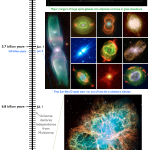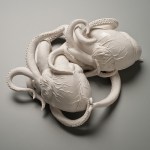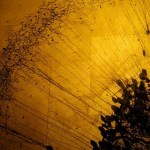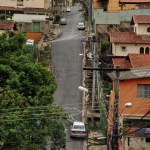biology
It's no secret that I've been highly critical of The Huffington Post, at least of its approach to science and medicine. In fact, it was a mere three weeks after Arianna Huffington launched her blog back in 2005 that I noticed something very distressing about it, namely that it had recruited someone who would later become and "old friend" (and punching bag) of the blog, Dr. Jay Gordon, as well as the mercury militia stalwart David Kirby, among others. As a result, antivaccination lunacy was running rampant on HuffPo, even in its infancy. Many, many, many more examples followed very quickly.…
The size and age of the Cosmos are beyond ordinary human understanding. Lost somewhere between immensity and eternity is our tiny planetary home. -Carl Sagan
If the story of our entire Universe's history, from the last stages of inflation and the Big Bang up to the present day, were to be compressed into one calendar year, what would it look like?
As 2011 comes to an end, here's my final present of the year to you.
(As always, click for a more readable, higher-resolution version.)
Happy new year to all; may you all enjoy our shared story and journey while you celebrate. See you in 2012!
Marie-Claire Shanahan teaches science education at the University of Alberta, and blogs about her own research and about the state of science education (and science education training:Â science education education if you will). Her latest post summarizes her findings from reviewing science teaching guides going back over a century:
Educators, critics, and scientists often argue for improving science education by teaching the processes of science, emphasizing critical thinking, and actively engaging students in doing science. Almost always, this is argued to be a great improvement over…
"If there is anything that a man can do well, I say let him do it. Give him a chance." -Abraham Lincoln
It was nearly four years ago that I started blogging back at my old site, branching out from the hardcore research of physical cosmology and the teaching of physics and astronomy, and into what I think of as science communication.
Image credit: The cover of Paul Halpern's book.
And there have been a number of very curious things I've learned, some of which I expected and some of which caught me by surprise.
The least surprising: the entirety of our experience in this world is something…
"Science is facts; just as houses are made of stone, so is science made of facts. But a pile of stones is not a house, and a collection of facts is not necessarily science." -Jules Henri Poincaré
The higher you fall from, the faster you'll be moving when you hit the ground.
Image credit: Marianne Holland.
Seems like the most obvious thing in the world. You know this intuitively, of course, based on all your experience in the world. Drop an egg from too great a height and it breaks.
While you wouldn't be afraid to jump off of a diving board like the one above, jumping from a greater height…
Came across this viper on a bike path one evening in July. It got shy when we stood around admiring it, so it disengaged from the shrew and slithered off into the greenery. May have saved it from getting run over by a bike.
Entangled, 2010
handbuilt porcelain, cone 6 glaze
Kate MacDowell sculpts partially dissected frogs, decaying bodies with exposed skeletons, and viscera invaded by tentacles or ants. It's the imagery of nightmares, death metal music videos, or that tunnel scene in the original Willy Wonka (not a speck of light is showing, so the danger must be growing. . . ). But her medium - minimalist, translucent white porcelain - renders her viscerally disturbing subject matter graceful, even elegant. Some of her pieces, like Sparrow, below, play off the porcelain's resemblance to delicate bleached bone.…
Photo of Vermont highway courtesy of Kyle Cornell
Last week, I had my long-awaited vacation semi-ruined when, thanks to Hurricane Irene, my flight back from the West Coast was cancelled. I had to rent a car and drive across the country in a rush - not my favorite way to spend three and a half days. But based on what I saw passing through New York, and what I've heard about the damage in Vermont, I can't complain: flooding has overturned homes, isolated entire towns, and destroyed everything some families own.
Vermonters are a notoriously self-sufficient bunch, and I haven't seen that much…
"I trust in nature for the stable laws of beauty and utility. Spring shall plant and autumn garner to the end of time." -Robert Browning
Like everything else that we know of in the Universe -- galaxies, stars, and planets -- human beings are made out of atoms.
Image credit: J. Roche at Ohio University.
And just like galaxies, stars and planets, over 99.9% of the mass of your body isn't just made up of atoms, it's made out of the nuclei of those atoms.
And if you go inside these atoms, into the heart of them, you'll find that these nuclei are combinations of two simple nucleons: the proton…
Gold Cortex
16 x 20, 2010
Greg Dunn
I used to have a beautiful gold Japanese folding screen, which was purchased by my great-grandmother's feisty sister on a trip in the 1920s. I loved the gold patina and the surprisingly modern impact it had on my wall. At the moment, it's loaned to a friend, but looking at Greg Dunn's artwork, I couldn't help but be reminded of the best aspects of my screen: the gold leaf, crisp black patterns, and way that the scene seemed half natural, half abstract.
The biggest twist Greg, a 6th year graduate student in neuroscience at the University of Pennsylvania,…
Gold Cortex
16 x 20, 2010
Greg Dunn
I used to have a beautiful gold Japanese folding screen, which was purchased by my great-grandmother's feisty sister on a trip in the 1920s. I loved the gold patina and the surprisingly modern impact it had on my wall. At the moment, it's loaned to a friend, but looking at Greg Dunn's artwork, I couldn't help but be reminded of the best aspects of my screen: the gold leaf, crisp black patterns, and way that the scene seemed half natural, half abstract.
The biggest twist Greg, a 6th year graduate student in neuroscience at the University of Pennsylvania,…
About a week ago, there appeared a story in the New York Times about recent discoveries in cancer research written by George Johnson and entitled Cancer's Secrets Come Into Sharper Focus. Overall, it was a better-than-average article for the lay press about recent discoveries in cancer research that go beyond just the cancer cell and just oncogenes. I must admit, however, that certain aspects of it irritated me, not the least of which is that it appeared to buy into one of the most cliched of tropes about medicine and science in spinning the story along the lines of "everything you know about…
Chalk Outline Tree
Armando Fontes (graffiti) and Catia Rissi (photographer)
Armondo Fontes and Catia Rissi call their chalk outlines of cut urban trees a "collective denunciation as an environmental graffiti." Fontes, who lives in the city of Belo Horizonte in southeastern Brazil, saw that trees were being cut and the city was not replacing them. He decided to engage in a guerilla art protest:
With the stumps that remain after cutting the trees, Fontes draws what would have been the shadow of the tree that once existed there. "I thought to refer to the universe of the cartoon. The silhouette…
From 1810-11, architect and amateur naturalist George Perry published The Arcana, a lavishly illustrated, serial natural history magazine. Although Perry intended for the serial issues to be assembled by his subscribers into a book, only thirteen complete copies are known to survive today. More than a third of the known copies are in Australia - perhaps fittingly, as Perry was the first to publish an illustration of the koala (above).
Perry's work is not well known; in researching this post, all I could find online were auction listings and occasional references to a recent facsimile…
All multicellular land species of life in Scandinavia are invasive: the area was covered by kilometres of ice until yesterday, geologically speaking. But some species are more recent invaders than others. Where I live, we currently have three species of large-bodied snail or slug: the Black slug (Arion ater, Sw. svart skogssnigel), the Burgundy snail (Helix pomatia, Sw. vinbergssnäcka) and the Spanish slug, (Arion vulgaris, Sw. spansk skogssnigel). That's the order in which they arrived: the Blacks during prehistory, the Burgundians most likely during the Middle Ages, and the Spaniards from…
My fascination with biopunks and DIYbio is well-established, and Eri Gentry is a hero in that world. Her talk about DIYbio at the recent Open Source Conference is a fascinating look not just at the potential for DIYbio and the motivations of biopunks, but a nice look at the ways people get pushed away from science, and get drawn back in.
Watch!
What other culture has invented a dish in which a squid is reanimated and dances as you pour soy sauce over it?
At first glance, this video might look like it's playing in reverse. But don't worry, these stroboscopic images were patched together in the right order.
Courtesy of Labcyte, Inc.
The video shows a technique called acoustic drop ejection (ADE) - an idea based on sending ultrasonic waves near the surface of a liquid to eject very small droplets. First demonstrated in the early 1920s, ADE is now being used by researchers to help them study extremely small biological molecules - like proteins and viruses - with x-rays at machines like Brookhaven's future National Synchrotron Light Source…
It's grant crunch time, as the submission deadline for revised R01s is July 5. However, in a classic example of how electronic filing has actually made things more difficult, the grant has to be done and at the university grant office a week before the deadline if it is to be uploaded in time. So, my beloved Orac-philes, I'm afraid it's reruns today, but, benevolent blogger that I am, I'll post two, one older, one more recent, but both about the same topic. This one's from 2007, which means that if you haven't been reading at least four years it's new to you.
A common refrain among…







